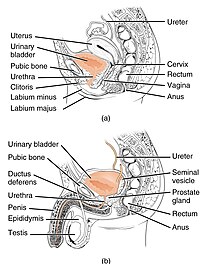
Photo from wikipedia
Introduction: This study is conducted to evaluate the long-term outcomes, including effectiveness and complications, of artificial urinary sphincter (AUS) implantation in men with primarily stress urinary incontinence. Materials and Methods:… Click to show full abstract
Introduction: This study is conducted to evaluate the long-term outcomes, including effectiveness and complications, of artificial urinary sphincter (AUS) implantation in men with primarily stress urinary incontinence. Materials and Methods: Consecutive patients with complete data sets and a continuous follow-up with the device in place for 5 years or more were included. We analyzed effectiveness through pads per day use, and complications were assessed based on device revisions and explantations. Various risk factors for revisions were evaluated and revision free-survival at 15 years was estimated. Results: Thirty-four male patients were implanted and followed for a mean of 116.5 months (range: 60–285). Mean pads per day use was significantly decreased from 3.6 at baseline to 0.6 at 1 year, 1.1 at 5 years, and 1.06 at last visit (P < 0.0001). During follow-up, 12 patients (35%) required between 1 and 3 device revisions and 1 (3%) required 5. The device revision-free survival was 76% (confidence interval [CI] 58%–87%) at 5 years and 56% (CI 32%–75%) at 15 years. A higher mean number of dilations or incisions for bladder neck contractures was a statistically significant risk factor for revisions in univariate analysis (odds ratio 1.8; 95% CI 1.02–3.2). No other significant risk factors for revisions were found. Explantations were performed in four patients for device erosion at 60, 69, 153, and 200 months. Conclusions: The AUS provides excellent long-term outcomes with continued improvement in continence rates and <50% of patients requiring revisions at 15 years. The previous history of bladder neck contractures and dilations may predispose to an increased rate of revisions.
Journal Title: Urology Annals
Year Published: 2019
Link to full text (if available)
Share on Social Media: Sign Up to like & get
recommendations!